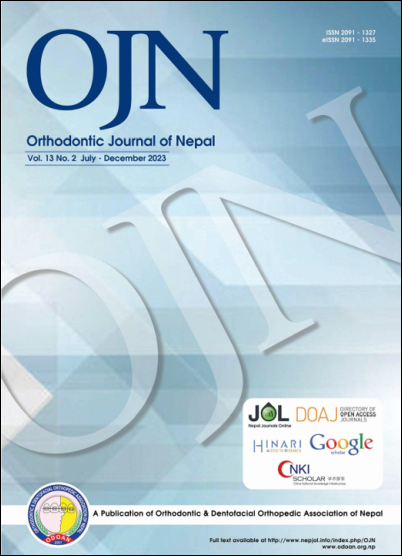Cephalometric characteristics of class II div 1 patients visiting tertiary care hospital in Southeastern Nepal
DOI:
https://doi.org/10.3126/ojn.v13i2.59736Keywords:
Class II Division 1, Lateral Cephalogram, Mandibular retrognathism, Maxillary prognathismAbstract
Introduction: Class II malocclusion can result from aberrant maxillary or mandibular dentoskeletal components with or without the involvement of soft tissue component. Identifiation of the cause in class II div 1 malocclusion with the help of lateral cephalograms is crucial in diagnosis and treatment planning.
Materials and Methods: Digital copies of lateral cephalograms of Class II div 1 patients visiting the Orthodontic department at Nobel Medical College were obtained. Web-based digital tracing, Webceph Plus version 1.5.0, was used for Steiner’s and McNamara’s analyses. The cephalometric values were compared with the established values of the Caucasians and the Nepalese norms wherever applicable. The comparison was done using an independent t-test with a level of signifiance set at 5%.
Result: As compared to Caucasians and Nepalese normal, Class II div 1 patients in our study had significantly increased ANB angle (6.4±2.1°, p<0.001) and proclined upper (UI-NA=28.7±7.3°, p< 0.001) and lower incisors (LI-NB=29.6±6.9° p<0.001). The Class II patients revealed decreased maxillary and mandibular effective lengths and maxilla-mandibular differences that were statistically signifiant, (p<0.001). The effective maxillary and mandibular lengths as well as the maxilla-mandibular difference were signifiantly greater in males than in females (p<0.05).
Conclusion: The study showed that class II div 1 patients had a combination of maxillary prognathism and mandibular retrognathism along with proclined maxillary and mandibular incisors. The effective lengths of the maxilla and mandible were greater in males as compared to females.
Downloads
Downloads
Published
How to Cite
Issue
Section
License
Copyright (c) 2024 Orthodontic & Dentofacial Orthopedic Association of Nepal

This work is licensed under a Creative Commons Attribution 4.0 International License.
Copyright © held by Orthodontic & Dentofacial Orthopedic Association of Nepal
- Copyright on any research article is transferred in full to the Orthodontic & Dentofacial Orthopedic Association of Nepal upon publication in the journal. The copyright transfer includes the right to reproduce and distribute the article in any form of reproduction (printing, electronic media or any other form).
- Articles in the Orthodontic Journal of Nepal are Open Access articles published under the Creative Commons CC BY License (https://creativecommons.org/licenses/by/4.0/)
- This license permits use, distribution and reproduction in any medium, provided the original work is properly cited.




